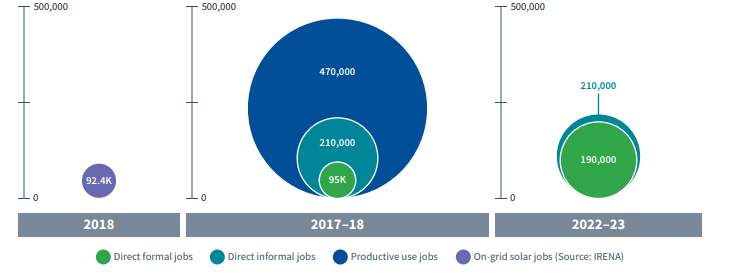Report
Powering Jobs Census 2019: Focus on India
Power for All, CEEW
July 2019 | Energy Transitions, Sustainable Livelihoods
Power For All, Schneider Foundation, The Rockfeller Foundation, and Council on Energy, Environment and Water
Overview
This report by Power for All, in collaboration with CEEW, disaggregates the decentralised renewable energy (DRE) employment landscape in India. It examines the skills trends, and future projections across the different DRE technologies surveyed. The report is a part of the Powering Job Census study which covers three emerging markets - India, Kenya, and Nigeria. Each country represents different sizes and stages of DRE market development. The deployment of DRE systems for energy access is emerging as a major opportunity to create jobs, which is critical as India’s unemployment challenges deepen.
Key Findings
- The direct, formal workforce in the DRE sector may double in size between 2017–18 and 2022–23 if the mini-grid market continues to expand at a rapid pace.
- Under a high mini-grid penetration scenario, the DRE workforce would provide 190,000 direct, formal jobs by 2022–23.
- The number of informal sector jobs will remain relatively consistent, due to the market remaining stable. About 210,000 informal jobs will serve the DRE sector between 2017–18 and 2022–23.
- Government support to productive use applications such as solar water pumping could add about 10,000 additional jobs. The Indian government plans to deploy 1.75 million solar water pumps through the KUSUM scheme between 2017–18 and 2022–23.
- Skills needs will depend on the evolution of the sector, with an expected shift from sales and distribution to operations & maintenance (O&M).
DRE sector employment estimates and projections

- The increase in mini-grid market share would see the demand for O&M rise significantly, between 12 percent and 24 percent of the sector by 2022–23 depending on the level of mini-grid penetration.
- Women’s participation in almost every type of DRE company is low, except for sector service providers. Mini-grid companies have a poor gender balance, with women comprising a mere 2 percent of the workforce.
- All companies in the DRE sector show high willingness to employ young people Manufacturing and upstream supply chain companies have the highest youth employment rate at 68 percent.
End-user product providers engage far more women through informal work, with 60% of their informal workers being women, often as sales agents.







